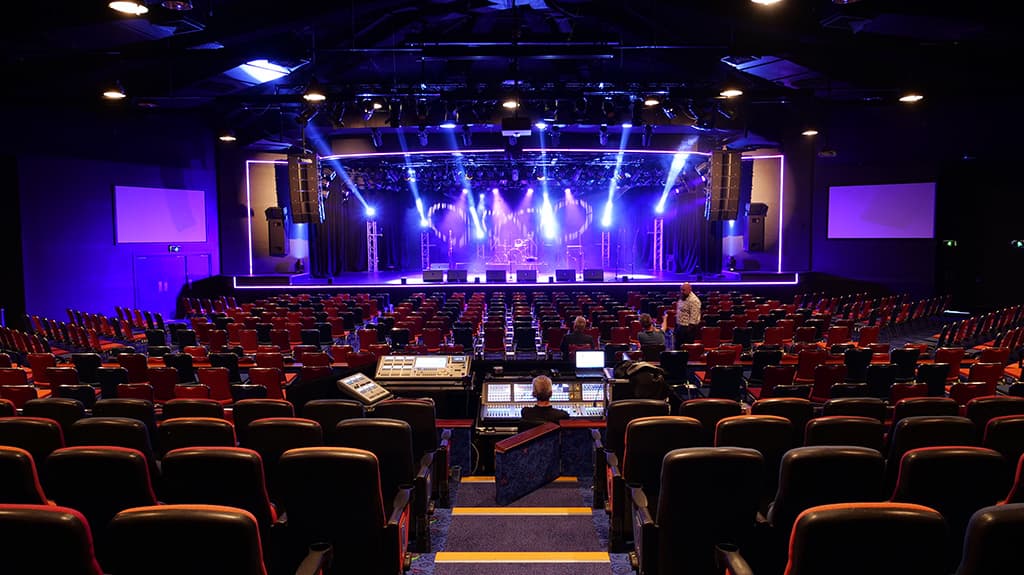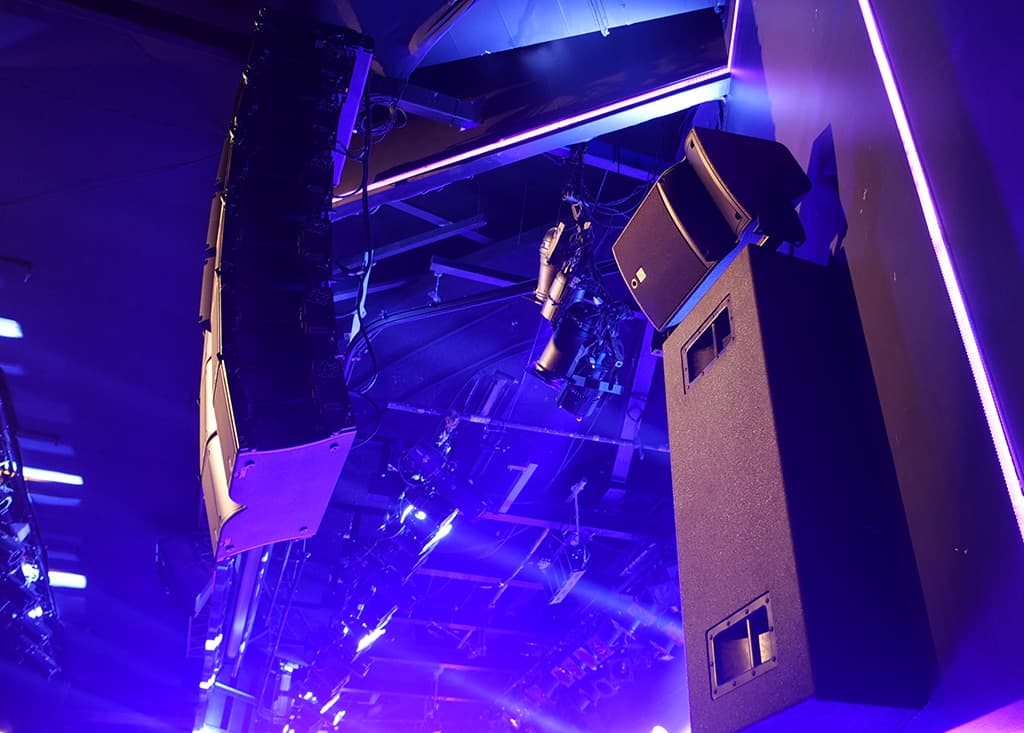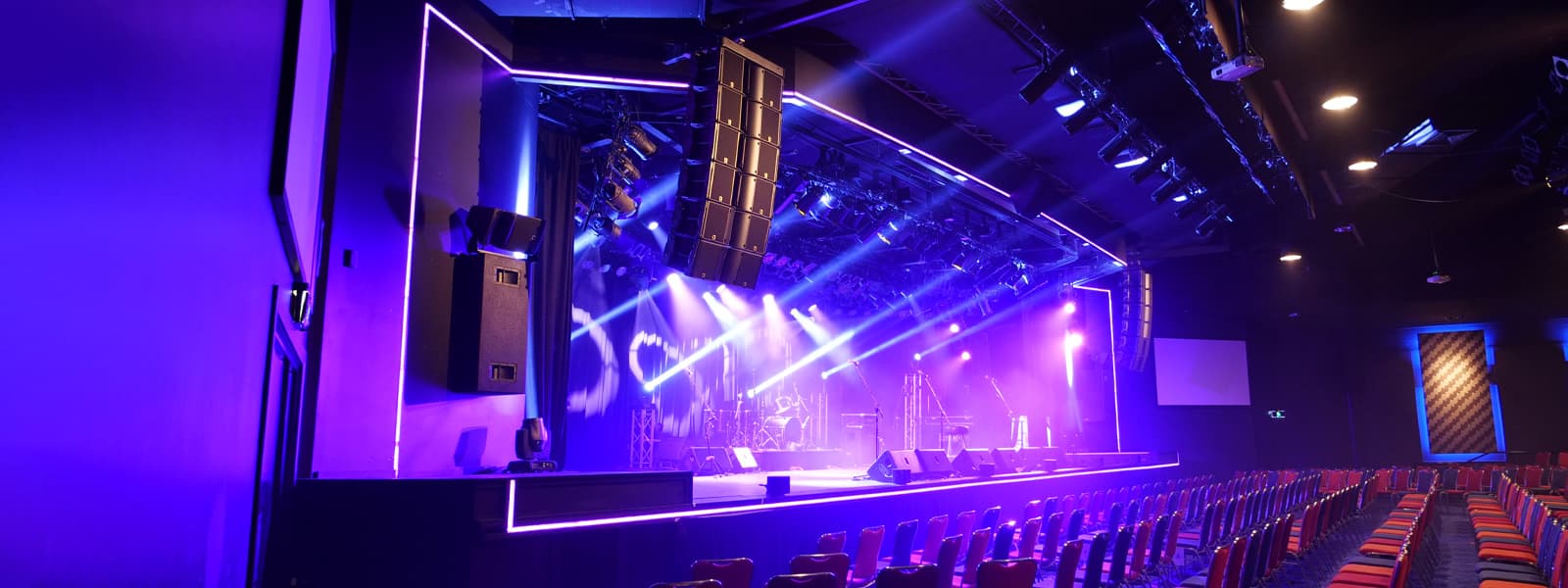Show Time
Twin Towns Showroom makes a generational investment in its future.
Story: Christopher Holder
Twin Towns Clubs & Resort:
2 Wharf St, Tweed Heads NSW
Twin Towns’ Operations and Production Manager, Lachlan Donaldson, isn’t one to waste a good crisis. When the club was effectively put into hibernation due to the first covid lockdowns, and most of the staff had been sent home, Lachlan had to find another gear. He had to cancel all the club’s entertainment and rebook dates for (much, much) later. But that was only the beginning. When most others around him could only see doom and gloom, Lachlan could see an ideal opportunity to take a completely clean slate approach to many of the settings surrounding the club’s entertainment offering — where the promotional and marketing budget is spent; how certain staff are hired; the role of free entertainment in the club, among other factors.
“It gave me the opportunity to cancel $800,000-plus worth of print advertising overnight,” reflects Lachlan Donaldson. “And dip our toes into more targeted digital advertising. We’ve been able to cancel free entertainment on one night, compare the numbers to the previous week and determine what difference it makes to revenue in other parts of the business. It’s been a golden opportunity to rethink the way we go about things.”
It also gave the club the opportunity to make a generational upgrade of its showroom loudspeaker systems without major interruptions to its operations.
NEW BROOM
As soon as Lachlan Donaldson took on the responsibility for the Twin Towns Showroom, he identified the immediate requirement of upgrading the aging PA.
The Showroom is a legendary venue. It’s around 1000-cap and has been a lynchpin in the area’s live scene for decades. There’s a large flat-floor flexible seating area, with raised and raked seating elsewhere.
Being a club venue, there’s a lot expected of the Showroom. On any given week it might play host to a stand-up comic, an annual general meeting, a tribute band or a heavy metal wig-out.
Lachlan immediately set about upgrading the audio, replacing the floor monitors, then the amplifiers but with each incremental improvement the focus intensified on the big-ticket item — a new front of house PA.
The board was lobbied hard. “I had two convincing arguments for the board,” explains Lachlan. “The first is a new PA will attract a better quality act. The second is an OH&S argument and probably the one that stuck with the board the most: if we install a PA that has broad industry acceptance, then we won’t have bands unloading their own production gear, which greatly reduces our chances of a workplace accident on our premises. The labour-hire road crew may have nothing to do with us, but if someone injures their back on our site we can be up for tens of thousands of dollars in compensation.”
Appealing to a board’s natural instinct to minimise risk is fiendishly clever. The board relented and gave Lachlan the green light.

LOSS LEADER TO BLACK INK
Every licensed club wishes they had a Lachlan Donaldson. He started out manning the Twin Town doors as a younger man before striking out on his own, running/owning Gold Coast nightclubs before returning to Twin Towns as a Production Manager. With every passing year he’s taken over more entertainment roles, including booking, operations, promotions and marketing. Effectively he’s doing the work most clubs would have a team assigned to. For its part, the club’s board appreciate his ability to take a fresh look at processes, blowing up some ‘holy cows’ of the club world along the way.
“My aim is to make the Showroom financially stand on its own two feet,” explains Lachlan. “When I started five years ago, it was a loss leader. Now it’s well on its way to making money. Ultimately, Twin Towns wants all areas of its business to be independently making money. If, for whatever reason, the gaming side of Twin Towns operations were curtailed, then the club would still remain a viable entertainment venue.”
For a manager so keen on rationalising the club’s entertainment offering, you might be forgiven for thinking Lachlan would be looking to go ‘lean and mean’ on a PA investment. Not so.
Norwest was asked to submit some loudspeaker designs for the room, which came down to two L-Acoustics options. NW Group’s CFO Graeme Whitehouse picks up the story: “We submitted a design based on L-Acoustics’ Kara II loudspeakers, which would have been an excellent choice for the space. Next to that, we submitted a ‘best case scenario’ option, based on the brand new K3 loudspeaker from L-Acoustics.”
We need to put ourselves in a position where the restaurants, The Showroom, and every other area of the club can trade independently of the revenue derived from gaming
K3 APPEAL
L-Acoustics’ K3 loudspeaker is its new go-to mid-size ‘Swiss army knife’ audio solution. It’s based on 2 x 12-inch low-frequency drivers and one HF unit coupled to the DOSC waveguide. It’s capable of a whopping 143dB in a 43kg box. Some of its versatility is down to a feature called Panflex. As first seen in the K2, Panflex can alter the horizontal dispersion (70°, 90° or 110°) of the enclosure. Not only that but Panflex can be asymmetrical, a feature used in The Showroom to help keep energy off the walls of the venue.
Six K3 elements are hung either side. Four L-Acoustics KS28 subwoofers are installed under the stage.
Sidefill and outfill are handled by L-Acoustics A10i loudspeakers. The A10i also features Panflex helping it to match its dispersion to the geometry of the room. A centre fill of 2 x A10i helps ensure excellent coverage in the centre; a single A10i on each side is used to fill in the seats on the far left and right; while two arrays of 2 x A10i each ensures coverage in the rear seating area.
Stage front infill is taken care of by low-profile L-Acoustics 5XT coaxial point source speakers. “The stage is so wide that the infill is required. Perhaps not so important on loud rock shows with plenty of backline but for spoken word or corporate gigs, it’s essential,” according to Graeme Whitehouse.
Part of the challenge was ensuring the experience in the back half of the room was as involving as the front. “The coverage is extremely even,” offers Graeme. “For anyone who’s done shows at the Showroom, they’d all suggest that it was tough to get it sounding great at the back, with sound coming off the back corners. But getting the dispersion right, with help from K3’s Panflex, and supporting the front of house system with the A10 outfill, it’s come up nicely.”
The loudspeakers are all powered by L-Acoustics LA12X and LA4X amplifiers.

CLUB LUXURY?
The choice of the L-Acoustics K3 PA puts Twin Towns’ Showroom in elevated company. It’s certainly the first K3 install in this part of the world. And without putting too fine a point on the figures involved, there’s not a lot of change out of A$400,000 after installation costs. You’d have to describe this as a flagship project; a statement… it’s the sort of investment that sends ripples. I asked Lachlan Donaldson the somewhat provocative question: ‘If the Showroom wasn’t part of Twin Towns but an independent live events venue, could he justify the investment?’ Without hesitation his response was: “One hundred percent. There’s not a doubt in my mind. I don’t think there’s ever an excuse for using subpar gear in the music world, because when people are paying you for a music experience, to see live music, you have to deliver that to the best of your ability. Otherwise, you’re not doing those paying patrons justice.
“If a venue was wondering if they could afford a model like the K3, I would say, just break it down: work out the how the cost of the PA works out per show over a minimum 10 year period. Work out how much you’re saving by not hiring gear in every week. Work out how much you can hire out the new system on certain shows or corporate events. You quickly realise that the capital cost become a lot more bearable.
“For me, the K3 was a long-term investment decision. The K3 is going to become the new standard and we wanted to be at the forefront of that. We want to be breaking boundaries.”
ALL WORTH IT
As in every other facet of the live music and events industries, there’s a palpable post-covid sense of relief. Almost like a collective, industry-wide exhalation.
And nothing says ‘we’re back’ quite like a full house. Earlier in the year Glenn Shorrock teamed with Brian Cadd for a ‘Two Amigos’ gig in the Showroom and the locals showed their appreciation by selling it out. Among the collective throng were members of the club’s board. It’s moments like these where big investments in providing the best possible live music experience make sense to everyone — the musicians, the tech crew, the management and the board. No doubt everyone hopes that there will be many more such moments.
LOCKDOWNS & SILVER LININGS
“The lockdowns revealed people’s attitudes and their fears. Initially, in the first four weeks, there was a widespread sense of dread — it was hard to see the light at the end of the tunnel. During that period, my support staff were largely sent home, so I had to step up and make things happen. I used it as an opportunity — I had a unique opportunity to completely rethink the way we did entertainment.
“Prior to covid we had lots of free entertainment — we had activations every day, often multiple activations every day. I used the lockdowns as an opportunity to completely wipe the roster. When we reopened, we reopened with no free entertainment, because the restrictions prohibited singing and dancing.
“I also used the lockdowns as an opportunity to cancel all of our longstanding contracts with print media, radio and the rest — I cut our advertising back to literally nothing. This then gave us the unique opportunity to start again with a completely blank slate. It meant I could look at Friday night’s figures compared to an equivalent Friday night when we had free entertainment. How much did that act add, in terms of gaming trade, in terms of food trade, in terms of bar trade? What is the free entertainment worth to club? We could determine that.
“We had the same opportunity to completely reassess our advertising. Instead of going back into newspaper advertising, I went into the digital space with News Xtend. We started with a very small social media campaign and individually tracked what the click-through rates were.
“We were formerly spending between $800,000 and $900,000 on print advertising for The Showroom, but last weekend we sold out shows without any print advertising. Which proves to me that we can achieve a result through targeting our activations and targeting our media.
“In many ways, covid has been an opportunity not a curse. We’ve been able to revitalise ourselves and to do things in a new way — a more effective and more cost-effective way.
“It’s an opportunity a lot of venues have missed. A lot of venues were in such a rush to reopen and get back to doing things the way they always have, and draw the same crowd they did before the pandemic that they’ve missed an opportunity. The world’s a different place. People’s habits have changed. We’ve definitely had to look at how we do things because the demographic coming to our shows has changed.
“Is everyone happy that we’ve lost some free entertainment? No. But they’re costing the club money without a commensurate return. The idea is to reinstitute activations that actually bring trade in.
“The Showroom used to run at a massive loss. I’ve been working to make it financially independent and profitable, through ticket sales alone. We need to put ourselves in a position where the restaurants, The Showroom, and every other area of the club can trade independently of the revenue derived from gaming. That’s been a process five years in the making and we’re almost there now. This year, I hope to actually be running at a cash flow positive and free of a subsidy-based model. I don’t know too many showrooms in venues that could say that.
“Am I winning popularity contests making these changes? Absolutely not. Once you move into management, you’re going to make unpopular decisions and you’re going to say things which people don’t want to hear. You have to accept that to do your job well, because you can never please everybody. My job is to align what I do to the board’s five-year or 10-year vision. I’m working in the club’s best interests as opposed to anyone else’s.”

